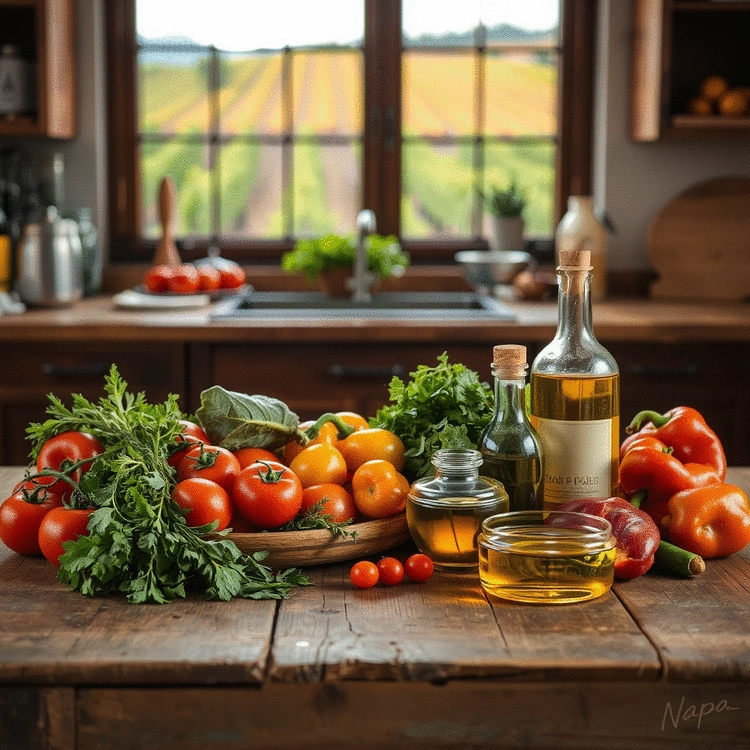
- Chef Insights
- Mar 24
2025-10-02
Did you know that Napa Valley's culinary scene is not only about taste but also about storytelling through local ingredients? As you explore this vibrant food landscape, you'll uncover the rich connections between farmers, chefs, and the land itself, making every meal an experience to savor.
The farm-to-table movement emphasizes sustainability, freshness, and local sourcing, fostering connections between chefs and local farmers. This approach not only provides diners with the freshest ingredients but also supports the local economy and promotes environmentally friendly farming practices. Below are the key principles visualized for clarity, illustrating how each element contributes to a unique dining experience in Yountville.
Dishes change based on what’s in season.
Ingredients are sourced from nearby farms and producers.
Emphasis on environmentally friendly farming practices.
Strengthening the local economy by supporting local farmers.
The culinary scene in Napa Valley is a vibrant tapestry woven from the threads of local ingredients, innovative chefs, and the rich cultural heritage of the region. When you stroll through the wine country, you can feel the pulse of food and flavor at every turn. It’s a place where each meal tells a story—stories of farmers, chefs, and the land itself. This is why Napa Tastes is dedicated to uncovering the unique experiences that make dining here truly special.
At the heart of Napa Valley’s culinary identity lies the farm-to-table movement. This approach connects diners directly with the source of their food, emphasizing freshness, sustainability, and local flavors. Imagine biting into a salad made from greens harvested just hours before—can you taste that crispness? It’s this immediacy and connection that elevates meals and creates unforgettable experiences.
Farm-to-table isn’t just a trend; it’s a philosophy that shapes our entire dining experience. Here, chefs are not just cooks; they are storytellers, showcasing the bounty of the land. By sourcing ingredients from local farms, they not only support the community but also offer a sense of place in every dish. Have you ever wondered how a chef’s choice of seasonal produce can change the way a dish tastes? It’s all about embracing what the land has to give!
The farm-to-table movement emphasizes the relationship between farmers and chefs, promoting a cycle of sustainability and freshness. This philosophy encourages chefs to create menus that change with the seasons, making every visit to a restaurant a new adventure. When you dine in Napa, you’re not just enjoying a meal; you're participating in a movement that values the earth and its gifts. Learn more about Napa Valley's sustainable culinary scene and its impact.
Here are some key principles of the farm-to-table movement:
Local ingredients truly define the culinary landscape of Napa Valley. When chefs use fresh, seasonal produce, the flavors burst with authenticity. You’ll find flavors that are richer and more vibrant than anything you might find in a supermarket. It's as if the local soil, sun, and farmers’ care are all packed into every bite!
Some of the standout ingredients include:
Each ingredient tells a story, and together they create culinary experiences that are uniquely Napa. When you sit down to eat, whether at a cozy bistro or an elegant restaurant, remember that you’re enjoying food that embodies the spirit of this beautiful region.
Napa Valley is home to some of the most acclaimed chefs, each contributing their unique style and vision to the local culinary scene. Their creativity and passion breathe life into the farm-to-table movement. When you dine at their establishments, you’re not just enjoying a meal; you’re savoring an experience crafted by artists who cherish local flavors. Discover more about Napa Valley's notable chefs and their contributions.
Some of these remarkable chefs include:
These chefs are more than just culinary professionals; they are ambassadors of Napa’s rich food culture. Their work inspires a sense of community and creativity, urging us all to explore the unique flavors of Napa Valley.
Here's a brief recap of the key points discussed so far:
When it comes to experiencing the culinary magic of Napa Valley, there’s no shortage of exceptional dining options. As I explore this vibrant food scene, I often find myself returning to the heart of Napa Tastes to share my top picks! Each restaurant in this region brings a unique flair and a dedication to incorporating local ingredients that truly define the essence of our area.
From rustic bistros to elegant dining establishments, the farm-to-table movement is alive and well here. Joining me on this culinary journey, let’s dive into some of the best farm-to-table restaurants that deserve a spot on your dining itinerary!
Let’s uncover where you can savor the freshest flavors directly from local farms. Each of these restaurants offers a chef-driven menu that celebrates the beauty of Napa Valley’s ingredients. Here’s a curated list of my personal favorites:
Each of these eateries embodies the spirit of Napa’s culinary scene, showcasing the talent of local chefs who are committed to sourcing their ingredients from nearby farms. Have you ever enjoyed a meal where each bite tells a story? That’s the magic you’ll experience here!
At these remarkable restaurants, the menus change with the seasons, offering a truly dynamic dining experience. You might find yourself enjoying a sumptuous dish featuring heirloom tomatoes in summer or a cozy squash soup as the leaves turn in autumn. Each chef’s creativity shines through, giving you a taste of what Napa Valley has to offer.
Pairing your meal with local wines is a must! Napa Valley is famous for its vineyards, and these restaurants often feature stunning selections to enhance your dining experience. Whether you’re a fan of bold reds or crisp whites, there’s a perfect wine waiting just for you!
To elevate your meal even further, consider these classic wine pairings with local dishes:
Choosing the right wine can transform your dining adventure into a delightful celebration of flavors. Trust me, there’s nothing quite like sipping a glass of local wine while enjoying a perfectly crafted dish!
As more people become curious about what makes Napa Valley’s culinary scene so special, I often receive questions about our local chefs and the ingredients they use. Let’s address some of the most common queries I encounter!
Many diners want to know what sets our chefs apart. Here are a few common questions I hear:
Understanding these practices helps you appreciate the thoughtfulness behind each meal you enjoy. It's what makes dining in Napa Valley a truly unique experience!
Local sourcing not only brings the freshest ingredients to the table, but it also fosters a connection between chefs and the community. By supporting local farmers, chefs can create dishes that are unique to Napa Valley, celebrating our rich agricultural heritage. Have you ever tasted a dish that felt like a little piece of home? That’s the beauty of local sourcing! This commitment to local sourcing is also a key aspect discussed in Napa Valley chef skills unveiled.
Napa Valley’s culinary landscape is truly a tapestry of flavors, textures, and stories. The influence of local ingredients on our chefs is evident in every bite. From farm-to-table experiences to innovative dishes that highlight our region’s bounty, there’s something magical about the dining scene here.
I encourage you to embark on your own culinary adventure in Napa Valley! Explore the unique restaurants, engage with our talented chefs, and savor the exceptional flavors that define our community. What will you discover on your culinary journey? I can’t wait to hear about your experiences! For more recommendations, consider exploring Napa Valley's finest dining spots.
Here are some common questions about the culinary practices and experiences in Napa Valley:
Here is a quick recap of the important points discussed in the article:
